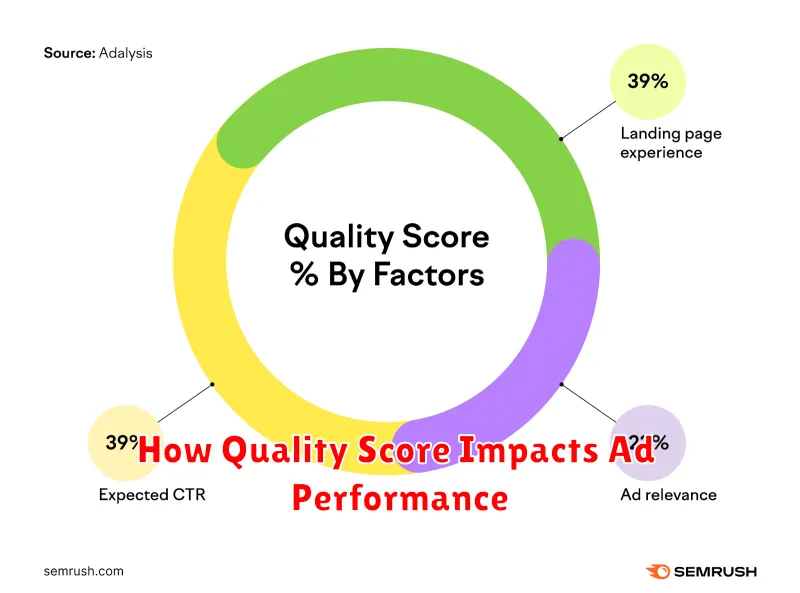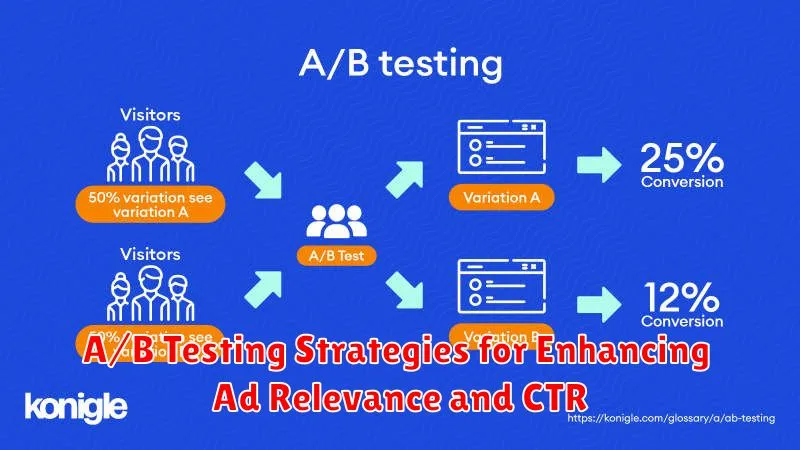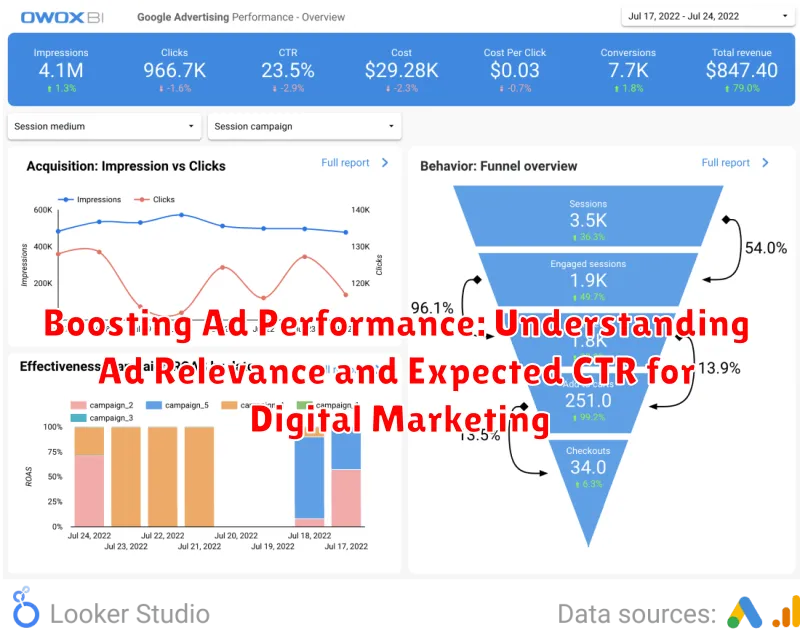In the dynamic landscape of digital marketing, achieving optimal ad performance is paramount for success. To maximize the effectiveness of your campaigns, it is essential to deeply understand the interplay between ad relevance and expected click-through rate (CTR). This article delves into these critical concepts, exploring how their synergy can significantly boost your ad performance and drive meaningful results across various digital advertising platforms. We will examine the fundamental principles that underpin ad relevance and how search engines and social media platforms assess the connection between your ads and the users they are shown to.
Ad relevance is a key factor influencing not only your Quality Score (in platforms like Google Ads) but also your overall ad auction positioning and cost-effectiveness. Furthermore, a high expected CTR serves as a powerful indicator of ad quality and user engagement, which can lead to improved visibility and lower costs per click. By mastering the art of crafting highly relevant ads with compelling calls to action and targeting strategies that resonate with your audience, you can unlock the full potential of your digital marketing efforts and achieve substantial gains in ad performance.
What is Ad Relevance and Why Does it Matter?
Ad relevance, in the context of digital advertising, refers to the degree to which an advertisement matches the intent of a user’s search query or the content of a webpage. It’s a crucial metric that search engines and advertising platforms use to determine the quality and usefulness of an ad.
Why does it matter? Primarily, ad relevance significantly impacts ad performance. A highly relevant ad is more likely to attract clicks, leading to a higher click-through rate (CTR) and a better Quality Score. This, in turn, can lower your cost-per-click (CPC) and improve your ad position.
Furthermore, relevant ads provide a better user experience. When users find ads that are closely aligned with their needs, they are more likely to engage positively with the brand and the offering, which translates to improved brand perception and increased conversion opportunities. Ads that miss the mark lead to wasted impressions, frustrated users, and lower overall campaign effectiveness.
Understanding Expected Click-Through Rate (CTR) in Advertising
Expected Click-Through Rate (CTR) is a crucial metric in digital advertising, representing the predicted likelihood that an ad will be clicked when shown to a user. Unlike observed CTR, which reflects past performance, expected CTR is a forward-looking estimate Google (or other platforms) uses to assess the quality and relevance of your ads.
This prediction is based on the ad’s historical performance, the keywords it targets, and the quality of the landing page. A higher expected CTR signals to the ad platform that your ad is relevant and engaging to users, which can lead to better ad positions and lower costs.
Therefore, understanding and optimizing for expected CTR is essential for maximizing the effectiveness of your advertising campaigns.
Factors Influencing Ad Relevance and CTR
Several key factors impact both ad relevance and click-through rate (CTR). Understanding these elements is crucial for optimizing digital marketing campaigns.
Keywords
The relevance of keywords to the search query is paramount. Using keywords that closely match user intent increases ad relevance.
Ad Copy
Compelling ad copy that resonates with the target audience and clearly communicates the value proposition significantly boosts CTR.
Landing Page Experience
A relevant and user-friendly landing page is essential. If the landing page doesn’t align with the ad’s promise, users are likely to bounce, negatively impacting CTR and overall ad performance.
Targeting Options
Utilizing precise targeting options, such as demographic, geographic, and interest-based targeting, ensures ads are shown to the most receptive audience, thereby increasing relevance and CTR.
How Quality Score Impacts Ad Performance

Quality Score is a diagnostic tool used by advertising platforms like Google Ads to assess the quality and relevance of your keywords, ads, and landing pages. It is a crucial factor influencing ad performance and overall campaign success.
A higher Quality Score can lead to:
- Lower Costs: Ads with higher Quality Scores often qualify for lower costs per click (CPC).
- Better Ad Positions: Higher scores can result in improved ad positions on the search results page.
- Increased ROI: By optimizing for Quality Score, advertisers can achieve a better return on their investment.
Conversely, a low Quality Score can lead to higher costs, lower ad positions, and diminished ROI. Focusing on improving your Quality Score through relevance and user experience is essential for maximizing the effectiveness of your digital advertising campaigns.
Strategies to Improve Ad Relevance for Higher CTR
To significantly enhance ad relevance and achieve a higher click-through rate (CTR), several strategic approaches can be implemented. One fundamental tactic is meticulous keyword research. Identify the most relevant and specific keywords that directly align with your target audience’s search queries and the content of your landing page.
Craft compelling ad copy that incorporates these keywords naturally while highlighting the unique value proposition of your product or service. Ensure your ad copy directly addresses the user’s needs or questions. Employ A/B testing to experiment with different ad headlines, descriptions, and calls to action to determine which variations resonate most effectively with your audience.
Ad Group Segmentation: Structure your ad campaigns into tightly themed ad groups. Each ad group should focus on a specific set of related keywords and feature ads that are highly relevant to those keywords. This precision targeting can dramatically improve both ad relevance and CTR. Regularly analyze performance metrics to identify areas for improvement and continuously refine your strategies.
The Relationship Between Ad Relevance, CTR, and Conversion Rates
Ad relevance, click-through rate (CTR), and conversion rates are intrinsically linked in determining the success of digital advertising campaigns. A high degree of ad relevance directly influences CTR; when ads are highly relevant to user search queries or browsing behavior, users are more likely to click on them.
Furthermore, a strong CTR can be a precursor to higher conversion rates. When users click on an ad, they are expressing initial interest. If the landing page and subsequent user experience align with the promises made in the ad (maintaining relevance), the likelihood of conversion significantly increases.
Conversely, low ad relevance leads to low CTR and subsequently, poor conversion rates. This can result in wasted ad spend and reduced ROI. Therefore, optimizing for ad relevance is crucial for maximizing both CTR and conversion rates, ultimately driving better advertising performance.
Tools for Measuring and Analyzing Ad Relevance and CTR
Effectively gauging ad relevance and click-through rate (CTR) is crucial for optimizing digital marketing campaigns. Several tools are available to assist marketers in this endeavor. These tools provide insights into how well your ads resonate with your target audience and the effectiveness of your ad copy and keywords.
Google Ads provides a Quality Score metric, which includes components of expected CTR, ad relevance, and landing page experience. Monitoring these metrics within the Google Ads platform offers a direct understanding of ad performance.
Third-party analytics platforms, such as SEMrush and Ahrefs, provide competitive analysis and keyword research tools that can help you identify relevant keywords and assess the performance of your ads relative to competitors. They can also offer insights into keyword difficulty and search volume.
A/B testing platforms like Optimizely allow you to test different ad variations and landing pages to determine which combinations yield the highest CTR and conversion rates. These platforms offer detailed reporting on the performance of each variation.
Optimizing Landing Pages for Increased Relevance
The landing page serves as the crucial point of conversion following an ad click. Its relevance to the ad and user intent directly impacts conversion rates and overall campaign success. Optimizing landing pages for relevance involves aligning the page’s content, design, and offer with the promise made in the ad.
Key strategies include:
- Keyword Consistency: Ensure keywords used in the ad are also prominently featured on the landing page.
- Clear Value Proposition: Immediately communicate the benefits of the offer.
- Seamless User Experience: Design a user-friendly page with a clear call-to-action.
- Mobile Optimization: Guarantee the landing page is responsive and performs well on mobile devices.
By focusing on these elements, marketers can improve the user experience, increase conversion rates, and ultimately enhance the ROI of their advertising campaigns.
A/B Testing Strategies for Enhancing Ad Relevance and CTR

A/B testing, also known as split testing, is a powerful method for optimizing ad relevance and click-through rate (CTR). By creating two or more variations of an ad element, marketers can determine which version performs better based on real-world user interactions.
Here are some A/B testing strategies:
- Headline Variations: Test different headlines to see which captures user attention most effectively.
- Description Text: Experiment with different ad copy to find the most compelling and relevant message.
- Call-to-Action (CTA) Buttons: Evaluate different CTAs to identify those that drive the most clicks.
- Image/Video Selection: Test different visuals to see which resonate best with your target audience.
- Keyword Targeting: Refine keyword targeting to improve ad relevance for specific search queries.
The key to successful A/B testing is to test one element at a time, ensuring that the results accurately reflect the impact of that specific change. Continuously analyze the data gathered from A/B tests and use the insights to refine your ad campaigns, leading to improved ad relevance and higher CTR.
The Future of Ad Relevance in Digital Advertising
The future of ad relevance in digital advertising is poised for significant evolution, driven by advancements in artificial intelligence (AI) and machine learning (ML). These technologies will enable more granular audience segmentation and personalized ad experiences.
Expect a shift towards:
- Predictive relevance scoring: AI algorithms will anticipate user needs and intent with greater accuracy, allowing advertisers to serve highly relevant ads in real-time.
- Contextual advertising expansion: Moving beyond keyword matching to incorporate a deeper understanding of the user’s environment, including device, location, and browsing history.
- Privacy-centric personalization: Balancing the need for personalized experiences with increasing user privacy concerns through anonymized data and advanced targeting techniques.
Ultimately, the goal is to create a seamless and valuable ad experience for the user, contributing to increased engagement and conversion rates for advertisers. Adapting to these changes will be crucial for maintaining a competitive edge in the evolving digital landscape.

